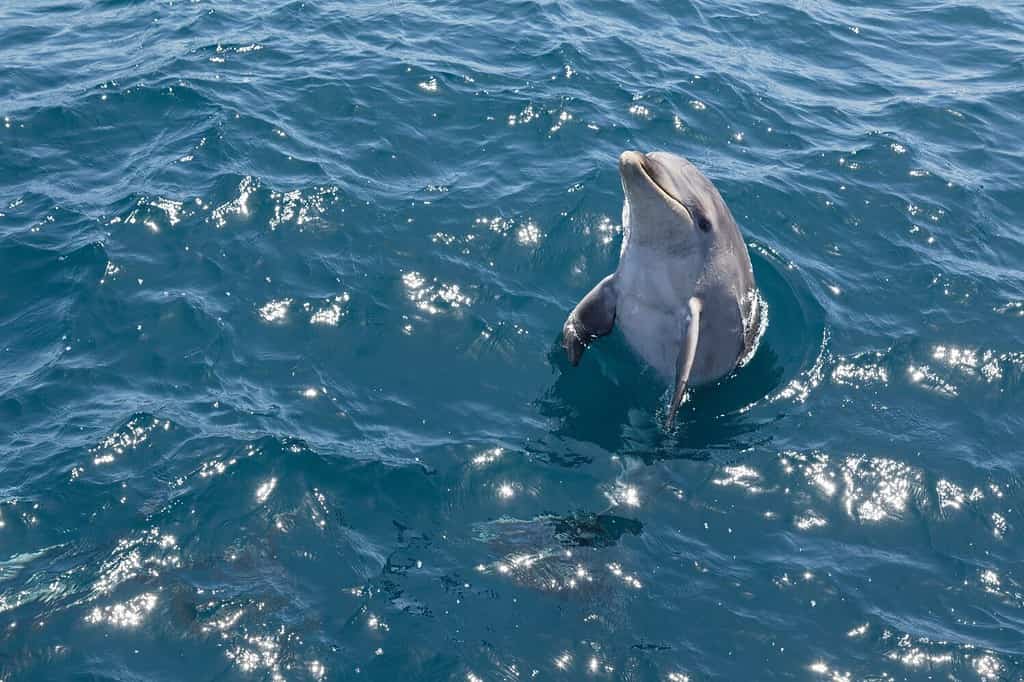Seeing them from the side of a boat or spotting them from shore overwhelms you with a sense of wonder. You think of guidance and intelligence as well as freedom and joy. Though they may grace humans with their presence, they only do so briefly before returning to their marine environment. Discover how long a dolphin can stay underwater!
Types of Dolphins
There are many different types of dolphins, some easier to recognize than others. The exact number is unknown, but it is estimated to be about 38, depending on the classification of the subspecies. Below is a small list of just some of the types of dolphins in the world:
Risso’s Dolphins (also known as gray dolphins)
These dolphins live up to 35 years, can weigh over 1,000 pounds, and grow up to 13 feet long. They like deep waters offshore and also enjoy swimming around the ocean’s surface.

Risso’s dolphins can grow to weigh over 1,000 pounds.
©Tory Kallman/Shutterstock.com
Dusky Dolphins
Dusky dolphins have beautiful patterns and are a popular tourist attraction in places like Chile, New Zealand, and South Africa.
Spinner dolphins
Spinner dolphins only grow up to seven feet long, weighing up to 170 pounds. Their small size allows them to perform stunning acrobatic displays as they leap out of the water, spinning just before they land back in with a splash.
Bottlenose dolphins
This common dolphin is the most easily recognized of the bunch and can live up to 60 years! They grow up to 13 feet long and can weigh well over 1,000 pounds.
Orcas (also known as killer whales)
Orcas also belong to the dolphin family and are very important for the ecosystem as they keep freshwater fish populations balanced.
Do Dolphins Breathe Underwater?
Dolphins are part of the marine mammal classification; therefore, they are warm-blooded and need oxygen to breathe. Fish, on the other hand, need to extract oxygen from the water through their gills. Dolphins have strong lungs, and they have to come up to the surface often enough to get air. Since they have been doing this for millennia, their bodies have evolved so much that they have an adapted mechanism to their lungs that helps to facilitate their breathing. Their circulation process is selective and the air sacs in their lungs make it so they can inhale more oxygen than humans. On the top of their head, there is a blowhole where they expel carbon dioxide and quickly inhale oxygen right before they go back into the water.

Dolphins spend a lot of time underwater but they need to come up for air.
©Paleokastritsa/Shutterstock.com
Depending on what it is they are doing, they can last several minutes underwater, or they can hold their breath until they get done with their task. When sleeping, dolphins swim slowly next to other animals, resting either horizontally or vertically. According to scientific literature, for thousands of years as far back as Ancient Greece times, there are tales about dolphins saving sailors from drowning. Even in modern times, there are reports of dolphins interfering, helping humans lost at sea. It’s not known exactly why these sea creatures gravitate toward humans, lending a helping fin, but it demonstrates their alertness, intelligence, and capacity for compassion.
How Long Can Dolphins Stay Underwater?
Whenever dolphins are underwater, their heart rate slows down, and their blood flow is redirected to their vital organs to conserve energy. They do have to stay in the water as it is imperative that they stay hydrated via their food sources (never seawater). However, they come up for air to ensure they are delivering enough oxygen to their bodies for survival. Part of their survival requires them to stick together in pods as there are predators in the ocean that may wish to turn them into a meal. Sharks, for instance, know to avoid large pods, exercising their tail fins to retreat when they encounter dolphin pods with one too many dolphins.

Whenever dolphins are underwater, their heart rate slows down, and their blood flow is redirected to their vital organs to conserve energy.
©slowmotiongli/Shutterstock.com
Why Can Dolphins Hold Their Breath for Extended Periods?
Dolphins have a high red blood cell count, which is how they are capable of carrying more oxygen in their system. They can store more oxygen in their muscles through a protein called myoglobin. They have an amazing adaptation to decrease blood flow to non-essential organs so that they can focus more on the critical organs like the brain and heart. Once they do that, they can last longer underwater. There is something they possess called the dive reflex, which is noteworthy as well. It is a physiological response that occurs the moment they submerge themselves. Their system automatically goes into energy-saving mode.
The photo featured at the top of this post is © iStock.com/Michelle de Villiers
Thank you for reading! Have some feedback for us? Contact the AZ Animals editorial team.







